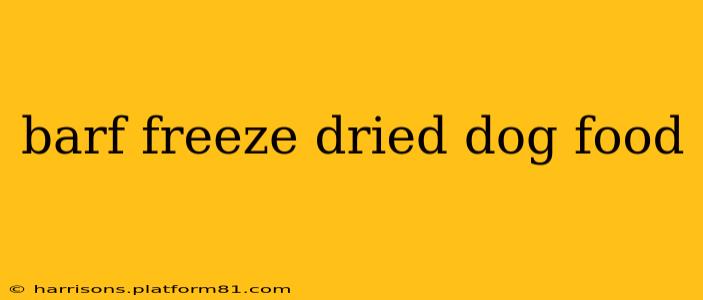Freeze-dried raw dog food, often associated with the BARF (Biologically Appropriate Raw Food) diet, is gaining popularity among pet owners seeking a natural and nutritious alternative to kibble. This guide delves into the benefits, drawbacks, and everything you need to know about barf freeze-dried dog food.
What is Barf Freeze-Dried Dog Food?
Barf freeze-dried dog food takes raw ingredients – meat, organs, bones, and sometimes vegetables – and removes the moisture through a freeze-drying process. This preserves the nutritional value and taste better than other preservation methods while significantly extending shelf life. Unlike raw food that needs refrigeration, freeze-dried food can be stored at room temperature, offering convenience without compromising nutritional integrity (although proper storage is still crucial). The process involves freezing the raw food and then subjecting it to a vacuum to remove the ice, leaving behind a dehydrated, nutrient-rich product. Rehydrating it before feeding is often recommended to restore its texture and palatability.
Benefits of Barf Freeze-Dried Dog Food
-
High Nutritional Value: Freeze-drying helps retain essential vitamins, minerals, and proteins often lost during cooking or other preservation methods. This can lead to a shinier coat, improved digestion, and increased energy levels in dogs.
-
Improved Digestion: The raw ingredients, often minimally processed, are easier to digest for many dogs compared to kibble, potentially reducing digestive upset and improving stool quality.
-
Enhanced Palatability: Many dogs find freeze-dried raw food more appealing than kibble, particularly picky eaters. The natural taste and smell of the ingredients often entice even the most discerning canine palates.
-
Convenience: Unlike fully raw food, freeze-dried food offers the convenience of long-term storage at room temperature. This makes it a more practical option for many pet owners.
-
Variety of Protein Sources: You can find freeze-dried raw food made with various protein sources, allowing you to tailor your dog's diet to their specific needs and preferences.
Drawbacks of Barf Freeze-Dried Dog Food
-
Cost: Freeze-dried raw food is generally more expensive than kibble.
-
Potential for Bacterial Contamination: Although the freeze-drying process significantly reduces bacterial load, there's still a small risk of contamination if not handled and stored properly. Always follow the manufacturer's instructions.
-
Nutritional Balance: It's crucial to ensure the freeze-dried food you choose provides a complete and balanced diet. Some products may lack certain nutrients, necessitating supplementation. Always consult your veterinarian before switching to a new diet.
-
Dental Issues: While bones are often included, they may not be sufficient for adequate dental cleaning. Regular dental care is still recommended.
-
Not Suitable for All Dogs: Certain dogs with compromised immune systems or specific health conditions might not be suitable candidates for a raw diet, even in freeze-dried form. Veterinary consultation is essential.
Is Barf Freeze-Dried Dog Food Right for My Dog?
The suitability of barf freeze-dried dog food depends on your dog's individual needs and your lifestyle. Consider the following:
-
Your Dog's Health: Consult your veterinarian before making any significant dietary changes, especially if your dog has pre-existing health conditions.
-
Your Budget: Freeze-dried raw food is more expensive than kibble.
-
Your Lifestyle: Are you comfortable with the storage and handling requirements?
How to Choose Barf Freeze-Dried Dog Food
-
Ingredient Quality: Look for products with high-quality, clearly identified ingredients. Avoid those with fillers, artificial preservatives, or excessive additives.
-
Protein Source: Select a protein source appropriate for your dog's age, size, and any allergies or sensitivities.
-
Nutritional Completeness: Choose products formulated to provide a complete and balanced diet. If unsure, consult a veterinary nutritionist.
-
Manufacturer Reputation: Choose reputable brands known for their quality and commitment to safety.
What are the potential risks of feeding my dog freeze-dried raw food?
The primary risk associated with freeze-dried raw food is the potential for bacterial contamination, though the freeze-drying process significantly reduces this risk compared to fully raw food. Improper handling or storage can increase this risk. Other potential risks include the possibility of nutritional imbalances if not chosen carefully, and the potential for choking hazards depending on the ingredients and the size of your dog.
Can I transition my dog to freeze-dried raw food gradually?
Yes, gradually transitioning your dog to a freeze-dried raw diet is recommended. A slow transition minimizes digestive upset. Start by mixing small amounts of freeze-dried food with your dog's current food, gradually increasing the proportion over several days or weeks.
How should I store freeze-dried raw dog food?
Freeze-dried raw food should be stored in a cool, dry place, away from direct sunlight and moisture. Always follow the manufacturer's storage recommendations. Once opened, transfer the food to an airtight container.
Is freeze-dried raw food better than kibble?
Whether freeze-dried raw food is "better" than kibble depends on your individual dog's needs and your priorities. Freeze-dried raw food offers potential benefits in terms of nutritional value and digestibility, but it's more expensive and requires careful handling. Kibble is convenient and affordable, but may contain less readily digestible ingredients and lower nutrient density. The best choice depends on your dog and your circumstances.
This guide provides a comprehensive overview of barf freeze-dried dog food. Remember to always consult your veterinarian before making any significant changes to your dog's diet. Choosing the right food is crucial for your dog's long-term health and well-being.
